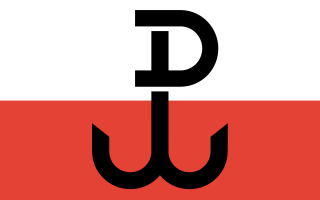
The Home Army was the dominant resistance movement in German-occupied Poland during World War II. The Home Army was formed in February 1942 from the earlier Związek Walki Zbrojnej established in the aftermath of the German and Soviet invasions in September 1939. Over the next two years, the Home Army absorbed most of the other Polish partisans and underground forces. Its allegiance was to the Polish government-in-exile in London, and it constituted the armed wing of what came to be known as the Polish Underground State. Estimates of the Home Army's 1944 strength range between 200,000 and 600,000. The latter number made the Home Army not only Poland's largest underground resistance movement but, along with Soviet and Yugoslav partisans, one of Europe's largest World War II underground movements.

The Jedwabne pogrom was a massacre of Polish Jews in the town of Jedwabne, German-occupied Poland, on 10 July 1941, during World War II and the early stages of the Holocaust. Estimates of the number of victims vary from 300 to 1,600, including women, children, and elderly, many of whom were locked in a barn and burned alive.

Hajnówka is a town and a powiat seat in eastern Poland with 21,442 inhabitants (2014). It is the capital of Hajnówka County. The town is also notable for its proximity to the Białowieża Forest, the biggest primaeval forest in Europe. Through Hajnówka flows the river Leśna Prawa. It is one of the centres of Orthodox faith and a notable centre of Belarusian culture in Poland. Belarusians comprised 26.4% of the town's population in 2002.
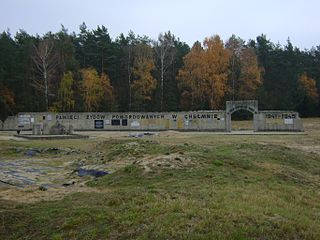
Chełmno or Kulmhof was the first of Nazi Germany's extermination camps and was situated 50 km (31 mi) north of Łódź, near the village of Chełmno nad Nerem. Following the invasion of Poland in 1939, Germany annexed the area into the new territory of Reichsgau Wartheland. The camp, which was specifically intended for no other purpose than mass murder, operated from December 8, 1941, to April 11, 1943, parallel to Operation Reinhard during the deadliest phase of the Holocaust, and again from June 23, 1944, to January 18, 1945, during the Soviet counter-offensive. In 1943, modifications were made to the camp's killing methods as the reception building had already been dismantled.

Białowieża is a village in Poland's Podlaskie Voivodeship, in the middle of the Białowieża Forest, to which it gave its name. The village is some 21 kilometres (13 mi) east of Hajnówka and 66 km (41 mi) southeast of the province capital, Białystok.

The Ordnungspolizei were the uniformed police force in Nazi Germany from 1936 to 1945. The Orpo organisation was absorbed into the Nazi monopoly on power after regional police jurisdiction was removed in favour of the central Nazi government. The Orpo was controlled nominally by the Interior Ministry, but its executive functions rested with the leadership of the SS until the end of World War II. Owing to their green uniforms, Orpo were also referred to as Grüne Polizei. The force was first established as a centralised organisation uniting the municipal, city, and rural uniformed police that had been organised on a state-by-state basis.

Gąbin is a small town in Płock County, Masovian Voivodeship, Poland, with 4,065 inhabitants as of December 2021. The Warsaw radio mast, which stood near Gąbin, was the tallest structure in the world until its collapse in 1991. It remained the highest structure ever created till 2010.
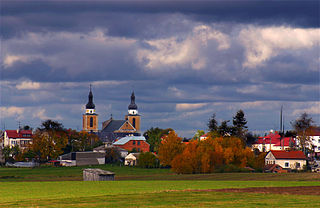
Stawiski is a town in northeastern Poland, situated within Kolno County, in Podlaskie Voivodeship, approximately 16 kilometres east of Kolno and 74 kilometres west of the regional capital Białystok. Stawiski is the administrative seat of Gmina Stawiski. From 1946 to 1975 it belonged administratively to Białystok Voivodeship, and from 1975 to 1998 to Łomża Voivodeship. The town is situated on the Dzierzbia River.
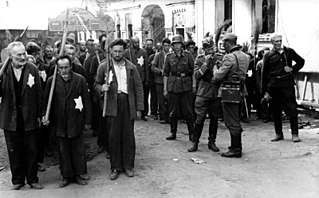
The German invasion of the Soviet Union started on 22 June 1941 and led to a German military occupation of Byelorussia until it was fully liberated in August 1944 as a result of Operation Bagration. The western parts of Byelorussia became part of the Reichskommissariat Ostland in 1941, and in 1943, the German authorities allowed local collaborators to set up a regional government, the Belarusian Central Rada, that lasted until the Soviets reestablished control over the region. Altogether, more than two million people were killed in Belarus during the three years of Nazi occupation, around a quarter of the region's population, or even as high as three million killed or thirty percent of the population, including 500,000 to 550,000 Jews as part of the Holocaust in Belarus. In total, on the territory of modern Belarus, more than 9,200 villages and settlements, and 682,000 buildings were destroyed and burned, with some settlements burned several times.

Staszów is a town in southeastern Poland, in Świętokrzyskie Voivodeship, about 54 kilometres southeast of Kielce, and 120 km (75 mi) northeast of Kraków. It is the capital of Staszów County. The population is 15,108 (2010), which makes it the 8th largest urban center of the province. The area of the town is 26,88 km2, and its two rivers are the Desta and the Czarna Staszowska.

The Holocaust in Poland was the ghettoization, robbery, deportation and mass murder of Jews, alongside other groups under similar racial pretexts in occupied Poland by the Nazi Germany. 3,000,000+ Polish Jews were murdered, primarily at the Chelmno, Belzec, Sobibor, Treblinka and Auschwitz extermination camps, who made up half of the Jewish Holocaust victims.

The Blue Police, was the police during the Second World War in the General Government area of German-occupied Poland. Its official German name was Polnische Polizei im Generalgouvernement.
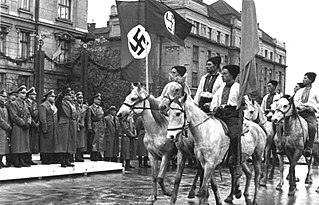
Ukrainian collaboration with Nazi Germany took place during the occupation of Poland and the Ukrainian SSR, USSR, by Nazi Germany during the Second World War.
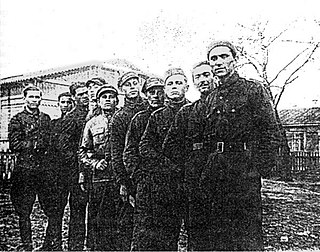
The Naliboki massacre was the 8 May 1943 mass killing of 127 or 128 Poles by Soviet partisans in the small town of Naliboki in German-occupied Poland.

Bialystok District was an administrative unit of Nazi Germany created during the World War II invasion of the Soviet Union. It was to the south-east of East Prussia, in present-day northeastern Poland as well as in smaller sections of adjacent present-day Belarus and Lithuania. It was sometimes also referred to by the designation South East Prussia along with the Regierungsbezirk Zichenau, although in contrast to the latter, it was not incorporated into, but merely attached to East Prussia.
The mass murders in Tykocin occurred on 25 August 1941, during World War II, where the local Jewish population of Tykocin (Poland) was killed by German Einsatzkommando.

Polish Jews were the primary victims of the Nazi Germany-organized Holocaust in Poland. Throughout the German occupation of Poland, Jews were rescued from the Holocaust by Polish people, at risk to their lives and the lives of their families. According to Yad Vashem, Israel's official memorial to the victims of the Holocaust, Poles were, by nationality, the most numerous persons identified as rescuing Jews during the Holocaust. By January 2022, 7,232 people in Poland have been recognized by the State of Israel as Righteous among the Nations.
The Koniuchy massacre or the Kaniūkai massacre was a World War II massacre of civilians, mostly women and children, carried out in the village of Koniuchy on 29 January 1944 by a Soviet partisan unit together with a contingent of Jewish partisans under Soviet command. At least 38 civilians who have been identified by name were killed, and more than a dozen were injured. In addition, houses were burned and livestock was slaughtered. It was the largest atrocity committed by the Soviet partisans in present-day Lithuania.

Stanisławów Ghetto was a ghetto established in 1941 by Nazi Germany in Stanisławów in German occupied Poland. After the German invasion of the Soviet Union, the town was incorporated into District of Galicia, as the fifth district of the General Government.

Adolf Hitler, dictator of Germany from 1933 to 1945, initiated World War II in Europe with the invasion of Poland in September 1939 and was central to the Holocaust. He was hated by his persecuted enemies and even by some of his own countrymen. Although attempts were made to assassinate him, none were successful. Hitler had numerous bodyguard units over the years which provided security.




















